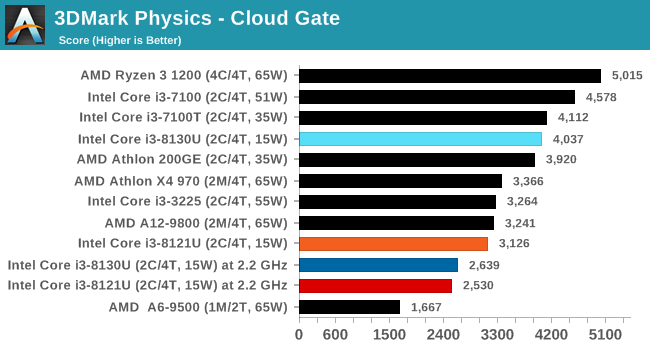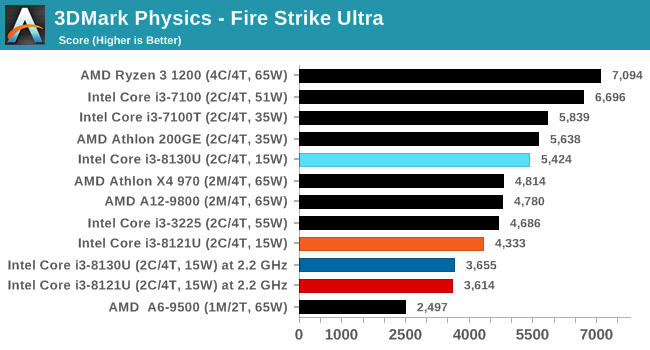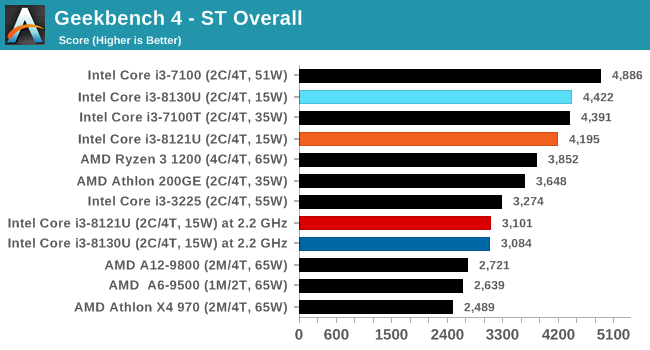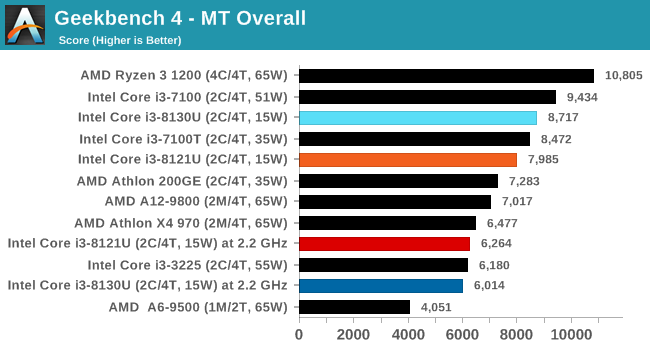Intel's 10nm Cannon Lake and Core i3-8121U Deep Dive Review
by Ian Cutress on January 25, 2019 10:30 AM ESTStock CPU Performance: Office Tests
The Office test suite is designed to focus around more industry standard tests that focus on office workflows, system meetings, some synthetics, but we also bundle compiler performance in with this section. For users that have to evaluate hardware in general, these are usually the benchmarks that most consider.
All of our benchmark results can also be found in our benchmark engine, Bench.
3DMark Physics: In-Game Physics Compute
Alongside PCMark is 3DMark, Futuremark’s (UL’s) gaming test suite. Each gaming tests consists of one or two GPU heavy scenes, along with a physics test that is indicative of when the test was written and the platform it is aimed at. The main overriding tests, in order of complexity, are Ice Storm, Cloud Gate, Sky Diver, Fire Strike, and Time Spy.
Some of the subtests offer variants, such as Ice Storm Unlimited, which is aimed at mobile platforms with an off-screen rendering, or Fire Strike Ultra which is aimed at high-end 4K systems with lots of the added features turned on. Time Spy also currently has an AVX-512 mode (which we may be using in the future).
For our tests, we report in Bench the results from every physics test, but for the sake of the review we keep it to the most demanding of each scene: Ice Storm Unlimited, Cloud Gate, Sky Diver, Fire Strike Ultra, and Time Spy.





In all tests, at fixed frequency, the processors act identical, however at stock frequencies that Kaby Lake chip just has more headroom to push.
GeekBench4: Synthetics
A common tool for cross-platform testing between mobile, PC, and Mac, GeekBench 4 is an ultimate exercise in synthetic testing across a range of algorithms looking for peak throughput. Tests include encryption, compression, fast Fourier transform, memory operations, n-body physics, matrix operations, histogram manipulation, and HTML parsing.
I’m including this test due to popular demand, although the results do come across as overly synthetic, and a lot of users often put a lot of weight behind the test due to the fact that it is compiled across different platforms (although with different compilers).
We record the main subtest scores (Crypto, Integer, Floating Point, Memory) in our benchmark database, but for the review we post the overall single and multi-threaded results.












129 Comments
View All Comments
0ldman79 - Friday, January 25, 2019 - link
This whole situation begs the question, what could Intel have gotten out of 65nm, 32nm, 22nm, etc, had they run it for five generations.I wonder if they'll do similarly on the 10nm process, punt the first time or two then knock it out of the park. Skylake was a beautiful success. Maybe Sunny Cove will be the same for 10nm.
StrangerGuy - Friday, January 25, 2019 - link
The point is Intel now needs better uarch designers lot more than process designers. Yes 10nm improvements is hard work and an interesting read...but for users they ultimately only care about end performance and perf/$, not die sizes, transistors/mm2 or manufacturing margins. If Zen 2 blows the doors off CFL would anybody even care about about Intel's process advantage? Hell not.KOneJ - Sunday, January 27, 2019 - link
Doubt this is even an "if" at this point. Curious to see if *Cove cores can keep Zen 4 and later from running away too much. Only time will tell, but Intel bringing in guys like Keller can't possibly be a bad thing. And in spite of their disastrous former attempts at building a dGPU, I fully expect Intel to make it happen this go around.eva02langley - Sunday, January 27, 2019 - link
The problem is, do you believe 7nm would be any different? Unless they implement EUV directly, I don't see it. Intel will be force, like AMD, to go fab less because their node will not be better than the competition. To add to it, it is most likely be behind in time to.zodiacfml - Saturday, January 26, 2019 - link
Great job again though it doesn't warrant it for this Intel junk. Looks like they're paying Lenovo just to use Cannon lake, usable chips that came from tuning manufacturing.The performance is where I expected it to be.
I still stand to my theory that Intel is reluctant to spend, leaving their engineers stressing if they can produce 10nm products without new equipment.
Anyways, it is a dead horse. AMD will be all the rage for 2019.
KOneJ - Sunday, January 27, 2019 - link
"Intel is reluctant to spend"To the contrary: throwing money at the problem is exactly what they're doing. Have you tracked their CAPEX these past few years?
"AMD will be all the rage for 2019."
I think that's basically a given.
zodiacfml - Sunday, January 27, 2019 - link
The reports were pretty vague and I don't remember them spending substantial money except the news that they're spending for more capacity on 14nm.AMD is pretty lukewarm for me last year. I'm certain that this year will be a lot stronger for AMD until Intel and Nvidia starts taking their customers more seriously.
KOneJ - Sunday, January 27, 2019 - link
Even for a company Intel's size, spending north of $12B a year isn't penny-pinching. I know their revenue and margins are massive, but their failings haven't been a lack of spending since SB. They've been progressively spending more than ever.YoloPascual - Saturday, January 26, 2019 - link
bUt 10nm iNtEL iS bEtTeR tHaN 7nm TSMC riGhT?KOneJ - Sunday, January 27, 2019 - link
Shouldn't your alias be yOlOpAsCuAl, wannabe troll?